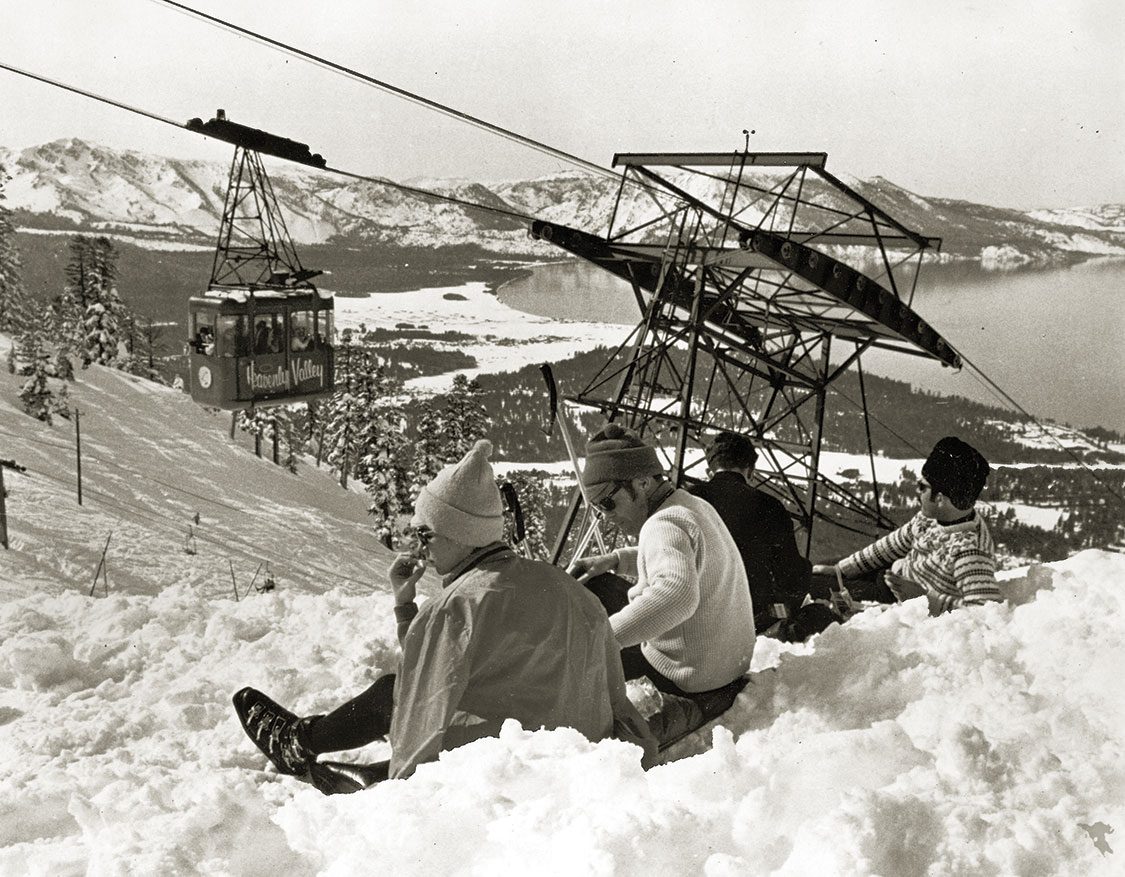
02 May 25 of the Best Things to Happen to Tahoe
From the contributions of famous land barons and ski resort founders to the positive impacts of traffic roundabouts, celebrity golf, bike paths and more, ‘good things’ abound from Tahoe’s storied past
With the magazine’s “Best of Tahoe” theme in mind, this cherry-pick through Tahoe’s history was compiled with input from several longtime local residents and community leaders, with items listed in roughly chronological order.
Do some of the selections have “shadows?” Undoubtedly. While historic events are often captured in monochrome photos, their legacies are seldom black and white. But on balance, whether for environmental or lifestyle reasons, they are wins for the Tahoe region.
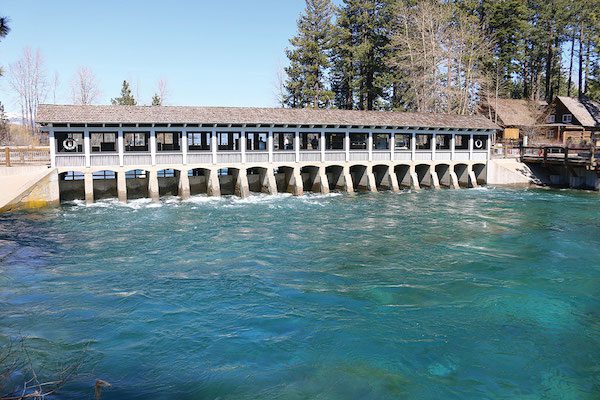
The Lake Tahoe Dam was built in 1913 and upgraded in 1987, photo by Sylas Wright
1. Lake Tahoe Dam
When the first Lake Tahoe Dam in Tahoe City was completed in 1870, it created predictable lake levels that enabled a “gilded age” in subsequent decades, with steamer ferries and motor launches traveling between the lake’s early resorts and marinas. Downstream, it lessened flood risk for Truckee and delivered a steady flow to Reno, Sparks, the Pyramid Lake Paiute Tribe and farmers in Fernley and Fallon. The current dam can hold back a little over 10 feet of Tahoe’s water. It replaced the old dam in 1913 and was upgraded in 1987. Listed on the National Register of Historic Places, the dam creates a whirlpool downstream that teems with large trout, attracting people leaning over the railing of the aptly named Fanny Bridge.
2. Tycoon Stewards
The historic 1800s “booms” of the American West—the California Gold Rush and Nevada’s Comstock Lode—birthed generational wealth and Tahoe’s first land barons. E.J. “Lucky” Baldwin purchased 2,000 acres of old-growth forest on Tahoe’s southeast shore in the 1880s and built a large casino and marina. He vowed to not log the big trees, with the land and estates passing down through his heirs and the Pope family to become the current Tallac Historic Site.
I.W. Hellman first purchased West Shore property in 1897 and eventually acquired almost 2,000 acres, now preserved as
Ed Z’berg Sugar Pine Point State Park. In 1928, Lora Josephine Knight purchased Emerald Bay’s shoreline, built her iconic Vikingsholm and Fannette Island tea house, then, along with future owners, preserved the scenic icon until it became Emerald Bay State Park (neighbored by D.L. Bliss State Park, donated by the family of the lumber baron).
No landowner in the Tahoe Basin is more consequential than George Whittell, who acquired most of the lake’s Nevada shoreline in 1935 and whose legacy includes Sand Harbor State Park and the preservation of miles of the East Shore. “You cannot deny the impact George Whittell left on Tahoe,” says Andy Chapman, president and CEO of Travel North Tahoe Nevada. “Logging and mining were rampant across much of the Tahoe Basin, but his vast 45,000 acres were left largely untouched beyond the Thunderbird Lodge.”
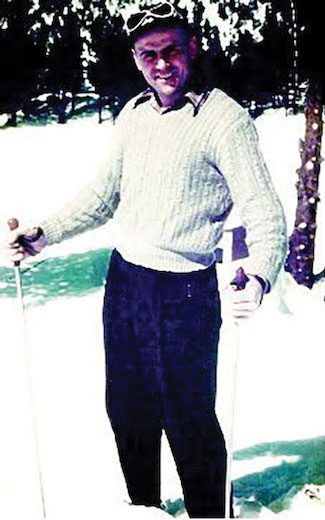
Chris Kuraisa, the visionary behind Heavenly Valley, which opened to skiers in 1955, photo courtesy Vail Resorts
3. Ski Resort Pioneers
Most Tahoe ski resorts have at least one early hero who invested cash and sweat equity to create a place now loved by thousands of skiers and riders. The list of consequential Tahoe ski industry pioneers is long, but among early members are Hannes Schroll at Sugar Bowl, which opened in 1939; Wayne Poulson, a ski jumping airplane pilot who had the vision for Olympic Valley and Palisades Tahoe and bought the property in the early 1940s; and Chris Kuraisa, who, with the help of some South Lake Tahoe neighbors, opened Heavenly Valley to skiers in 1955, digging some of the lift tower footings himself.
4. 1960 Winter Olympics
When the International Olympic Committee awarded the Winter Games to what is now Palisades Tahoe on April 4, 1956, it jump-started Tahoe’s winter economy and its transformation into a world-class ski destination. Two months after the Olympic announcement, construction of Interstate 80 over Donner Summit was green-lighted in Washington, D.C. Real estate and ski resort developers kicked plans into high gear to create new communities and resorts now called Kirkwood, Northstar, Alpine Meadows and Tahoe Donner.
5. U.C. Davis Research
In 1958, with the upcoming Winter Olympics promising a slew of development, Dr. Charles Goldman of the University of California Davis Zoology Department began regular testing of Lake Tahoe’s water quality and clarity. His early research helped fuel Tahoe’s environmental movement. In subsequent years, Goldman and his successors created what is now the U.C. Davis Tahoe Environmental Research Center, with its continual research giving Tahoe a leg up in mitigating future challenges.
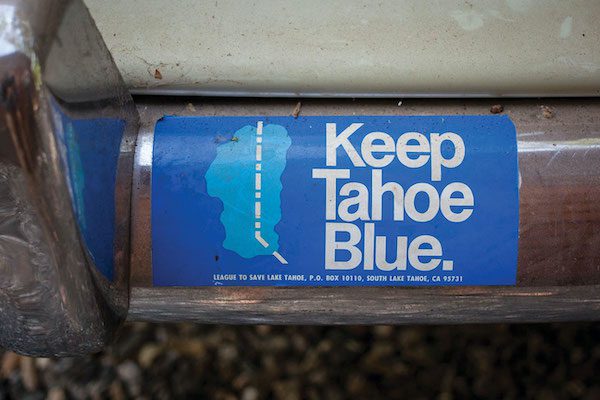
‘Keep Tahoe Blue’ bumper stickers date to the early 1970s, photo courtesy League to Save Lake Tahoe
6. ‘Keep Tahoe Blue’ Bumper Stickers
The slogan of the League to Save Lake Tahoe has been viewed on car bumpers coast-to-coast for over 50 years. The League, founded in 1957, began printing the enduring design in the early 1970s, and the stickers have since spread a message of collective responsibility to protect Tahoe’s environment. As an organization, the League was instrumental in lobbying for early regulations on pollution and development in Tahoe and continues its stewardship and outreach efforts, focusing on solutions to traffic, litter and invasive species.
7. Incorporation of South Lake Tahoe and Truckee
Voters who incorporated the cities of South Lake Tahoe and Truckee gave generations of residents more control over their communities, with cascading positives as a result. South Lake Tahoe incorporated in 1965, combining the previously unincorporated communities of Al Tahoe, Bijou, Bijou Park, Stateline, Tahoe Valley and Tallac Village. After arguing about self-rule for over a century, Truckee voted to become a town in 1992, with poor road conditions and spotty snow removal pushing the measure over the line. Benefits to residents of both cities have been significant in terms of local control, upgraded facilities and amenities.
8. Exporting Sewage
Researchers and advocacy groups celebrated a historic victory in preserving Tahoe’s water quality when legislatures in both California and Nevada voted in 1969 to cease the discharge of sewage into Tahoe Basin ground and lake water, with California mandating it be completed by 1972. South Lake Tahoe and agencies around the lake explored innovative solutions, creating systems that, by 1975, exported all sewage out of the Basin, now treating it to release clean water into the lower Truckee River. While not infallible to broken pipes and overflows, legislative action a half century back gave the lake a fighting chance to stay clear.
9. Tahoe Regional Planning Agency
The formation of the Tahoe Regional Planning Agency (TRPA) was a critical turning point in preserving Lake Tahoe’s natural beauty. “Without its leadership, Tahoe’s delicate ecosystem would have faced devastating impacts from unchecked development,” says Placer County Supervisor Cindy Gustafson, who represents the county on the agency’s board of directors.
Launched by California and Nevada in 1969, the agency was initially in turmoil. It was not until 1981 that California approved the final bi-state compact. The agency was heavily criticized after issuing two moratoriums on new construction in the early 1980s. While the TRPA remains controversial, currently receiving flak for what’s perceived as weighing in favor of economic development over conservation, its record of environmental achievements is decades-long.
“TRPA prevented a city the size of San Francisco from ringing the shores of Lake Tahoe through groundbreaking policies to stop runaway growth,” says TRPA’s Jeff Cowen, who lists among the agency’s accomplishments: developing a science-based plan to return lake clarity; dramatically reducing boat pollution; protecting Tahoe from invasive species; creating more walkable town centers; and accelerating wildfire protection.
10. Public Land Acquisition Programs
California Tahoe Conservancy was created in 1984 with a mission to purchase and protect thousands of properties inside the Basin, many located in environmentally sensitive zones, as well as partner with local agencies on community improvements. Across the border, Nevada Division of State Lands and its Tahoe Resource Team own and manage over 500 Tahoe properties. The U.S. Forest Service has played a crucial conservation role in the Basin, as well, including purchasing key parcels at Stateline that were scheduled to be sites for two additional high-rise casino towers. “State and federal land acquisition programs have preserved open space, protected critical habitat, compensated landowners, preserved historic sites and increased recreational opportunities,” says Tahoe historian and author David Antonucci. “In 1963, only 48 percent of Tahoe land was owned by public agencies. Today, that figure stands at 84 percent.”
11. Regional Nonprofits
Tahoe’s local nonprofits have supported and enriched the lives of residents, guided the growth of communities, and protected and cleaned up the environment. Among the efforts launched in the late-1960s and ’70s are the Truckee-Donner Historical Society, South Lake Tahoe Family Resource Center, Lake Tahoe Humane Society, North Lake Tahoe Historical Society, Sierra State Parks Foundation, Tahoe Nordic Search and Rescue, and North Tahoe Fine Arts Council. Startups in the 1980s and ’90s include the Humane Society of Truckee-Tahoe, Incline Village’s Pet Network, Truckee Donner Land Trust, Mountain Area Preservation, Truckee River Watershed Council, and the overarching Parasol Tahoe Community Foundation and Truckee Tahoe Community Foundation. In the 15 years since Tahoe Fund launched, it has secured more than $160 million in public funds for over 160 projects. Volunteers and donors to these and many other local nonprofits are clearly some of the “best things” to happen to Tahoe.
12. Community Recreation Centers
Indoor community gyms and pools enrich the lives of many residents, especially during long Tahoe winters. South Lake Tahoe Community Pool opened in 1975. The Ice Arena was constructed nearby in 2003 and the city plans to open a new Recreation & Aquatics Center in 2026. Incline Village Recreation Center opened in 1992 and Truckee-Donner Community Swimming Pool in 2016.
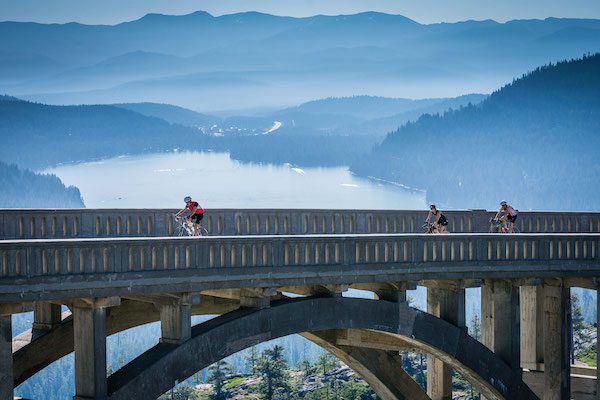
Participants in the annual Donner Lake Triathlon cycle across Rainbow Bridge on a hazy summer morning, photo by Harry Lefrak, courtesy Big Blue Adventure
13. Human-Powered Ultra-Races
Since the days of Snowshoe Thompson, ultra-athletes have been part of this area’s culture. The DeCelle Memorial Lake Tahoe Relay is the oldest distance relay in the country, the first batons passed in 1964. The world’s first 100-mile trail race, Western States Endurance Run, began in 1977 (after Gordy Ainsleigh ran the course with Tevis Cup horses three years earlier). Les Wright launched the Lake Tahoe Marathon as a fundraiser in 1976. The first Great Ski Race was held in 1978, and the Death Ride Tour of California’s Alps became an instant cycling classic that same year. The Donner Lake Triathlon started in 1982 and is one of the sport’s longest-lived contests, now organized by Big Blue Adventure event company. These and many more contests are popular with demos that tourism leaders tell us we want. And the races are fun for locals, too!
14. Paved Bike Paths
Paved bike paths have become an essential part of the Tahoe experience for many visitors and residents. But 40 years ago, a walk or ride here was likely on dirt, snow or mud. The Tahoe region began building its network of bike paths in the late 1970s. The West Shore Trail was constructed south of Tahoe City that decade, as was the Pope Baldwin Bike Path on the South Shore, completed in 1978. The Truckee River Trail opened downstream from Tahoe City in 1980. The Town of Truckee had almost zero bike paths in 2000 but now boasts 20 miles of paths, including the popular Truckee River Legacy Trail to Glenshire. The Tahoe East Shore Trail was completed in 2019 from Incline Village to Sand Harbor and has been hugely popular since day one. “That trail has transformed the East Shore into a safe and enjoyable experience open to all, with water quality improvements built in,” says Amy Berry, CEO of the Tahoe Fund.
15. Historic Truckee Preservation
The preservation of Truckee’s historic downtown was no accident. Local pride played the essential role for well over a century. Before the town’s incorporation in 1992, “Nevada County used its regulatory authority to ensure that prominent historic buildings were not needlessly torn down and the character of downtown maintained,” says former Truckee Town Manager Tony Lashbrook. “When downtown Truckee became a National Historic District, locals embraced it and have taken steps to preserve it.”
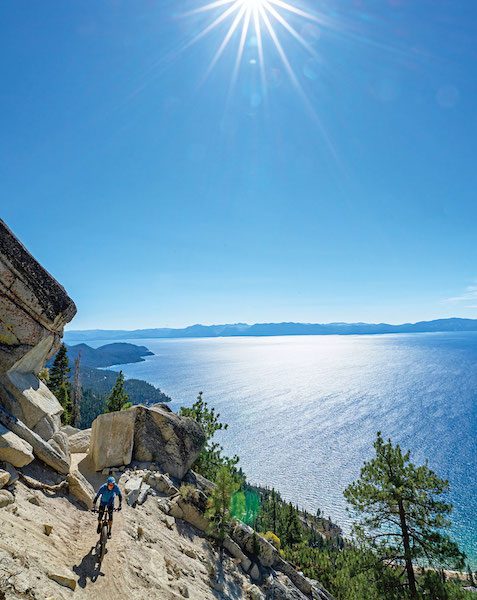
Greg Johnson enjoys a bluebird day on the Marlette Flume Trail, photo by Anthony Cupaiuolo
16. Mountain Bike Trails
In 1983, mountain biking was in its adolescence, spilling out of its Northern California birthplace into the Sierra Nevada. A top racer at the time, a young Max Jones explored and cleared the path of an 1800s logging flume above Tahoe’s East Shore, unwittingly creating a renowned mountain bike trail in the process.
“Max Jones’ discovery of the Marlette Flume Trail put Tahoe on the map for the best mountain biking in the world,” says Berry of the Tahoe Fund.
Mountain bike culture took root quickly, with Olympic Bike Shop in Tahoe City opening in 1975 and Sierra Ski & Cycle in South Lake Tahoe in 1980. As mountain bikers flocked here, local riders formed the Tahoe Area Mountain Biking Association (TAMBA) in 1988. The organization has proven exemplary in the sport, working with government agencies to construct new environmentally sensitive trails and maintaining over 100 miles of local trails.
“Tahoe is beyond compare for mountain bike riding,” says Peter Underwood, co-owner of Olympic Bike Shop. “With new trails being built every year, you never have to ride the same trail twice … unless you’ve found your new favorite.”
17. Edgewood Tahoe’s Celebrity Golf Tournament
Thirty-five years ago this summer, sports heroes and celebrities first teed off in the now famous American Century Championship. The multi-day network television coverage is a video postcard for the region, with commentators and world-class athletes gushing Tahoe superlatives. The tournament generates countless online stories and impressions, a publicity value that Weidinger Public Relations pegs at $435 million annually. In addition, the event has donated over $2.25 million to 90 Tahoe-area nonprofits.
18. Lake Tahoe Restoration Act
Passed by U.S. Congress in 2000 and renewed in 2016 and 2024, the Lake Tahoe Restoration Act has brought hundreds of millions of dollars to the Tahoe Basin largely in the form of forest, wetlands and watershed restoration. The act received its initial momentum with the visit of President Clinton and Vice President Al Gore in 1997 and was financed in part by the sale of federally owned property near Las Vegas. The repairs to stream zones and the forest clearing accomplished by the act have had a clear impact on wildfire prevention and the stabilization of Tahoe’s water clarity.
19. Traffic Roundabouts
Proven in Europe, early traffic circle “roundabouts” in Tahoe were nevertheless a contentious issue at first. When Truckee’s McIver Crossing roundabout was proposed in 1998, a prominent local coined it the “circle of death,” says Lashbrook, the former town manager. “It was the first roundabout in the region, but now there are more than 10 in Truckee alone.” Before adopting roundabouts, Truckee had calculated they’d have to add 18 stoplights to handle projected increases in traffic.
Key roundabouts now keep traffic flowing in Meyers at the U.S. Route 50/Highway 88 junction, at the base of Mount Rose Highway in Incline Village and in Tahoe City, where the two roundabouts connecting a new bridge over the Truckee River have significantly diminished West Shore congestion. While design snafus initially plagued Kings Beach’s roundabouts, those are now largely solved, and a new roundabout is planned at the junction of highways 267 and 28.
20. South Shore Redevelopment
Despite delays and open holes in the ground, redevelopment launched by the City of South Lake Tahoe in 1988 has transformed its Stateline area into a world-class four-season destination. Land once occupied by aging motels and shops is now the lively Heavenly Village, with upscale accommodations and a gondola that welcomed its first passengers in 2000. While redevelopment plans are not completed, the work accomplished has created an upgraded visitor experience and fixes to long-standing environmental problems.
21. Tahoe Rim Trail
When all elements of the Tahoe Rim Trail were linked in 2001, it caught the attention of national media and the public. The trail moved Tahoe farther up the list of must-visits for hikers and trail runners everywhere. Whether tackling all 170 miles or biting off smaller sections, the Tahoe Rim Trail records millions of visits annually from locals and tourists alike.
22. Highway 267 Overpass Bridge
Prior to 1998, peak traffic days put Truckee into gridlock. All Highway 267 traffic from Northstar and Tahoe’s North Shore funneled down one street in the middle of town, stopped outright by every passing train. Even without trains, the intersections between River Street and Commercial Row and Highway 267 were bottlenecks that “literally made it impossible for anyone, even emergency vehicles, to make it across town,” says Lashbrook. The situation was alleviated when a new tunnel was cut under the train tracks—McIver Crossing near Burger Me—and more dramatically when the long span of the Truckee Highway 267 Bypass bridge was completed in 2002, connecting Interstate 80 and Highway 89 North to Highway 267 without passing through downtown Truckee.
23. Free On-Demand Microtransit
“Microtransit has proven to be an important part of Tahoe’s transportation solution,” says Joy Doyle, executive director for the Mountaineer system of free vans serving Olympic Valley and Alpine Meadows. Mountaineer began as a test in 2018, with the concept then adopted by Tahoe Truckee Area Regional Transit in its on-demand TART Connect vehicles, providing free door-to-door service in Truckee, Incline Village, Crystal Bay, Kings Beach and Tahoe City. A similar Lake Link Micro Transit provides free service for visitors and locals within the South Shore’s core. Over six years, the three systems have collectively transported over 2 million passengers, according to Doyle. The transit is financed in part by on lodging fees and Tahoe Blue Event Center tickets.
24. Lake Tahoe Destination Stewardship Council
While agencies around Tahoe have collaborated on specific projects for years, when formed in 2023, this council brought together “everyone from regional land managers to local governments to visitors authorities to our local tribes, all of Tahoe working on a singular mission: taking care of Lake Tahoe for our locals, visitors and all who appreciate our shores and lands,” says Andy Chapman, who is a member of the council. The council is a product of a shared realization that it’s imperative to find a balance between the economic benefits that visitors bring and the detrimental impacts of overtourism on residents’ lifestyles and the environment.
25. Tahoe Blue Event Center
The new Tahoe Blue Event Center at Stateline has added an essential component to the South Shore’s year-round destination appeal: a modern, versatile venue for events and conferences. The event center is owned by Tahoe Douglas Visitors Authority and managed by OVG 360, which has 400 entertainment venues worldwide in its portfolio. The center features over 50,000 square feet of meeting, convention and exhibition space and is home to the Tahoe Knight Monsters minor league professional hockey team. “It’s fast become a community gem,” says Carol Chaplin, president and CEO of the Lake Tahoe Visitors Authority, adding that the center provides an estimated $60 million boost annually to the South Lake Tahoe community.
GREAT NEW IDEAS
Sawmill Solution
A fortunate partnership created a quick solution to what had previously impeded the clearing of dead trees from Tahoe’s forests: a nearby sawmill. Investor Kevin Leary teamed up with Tahoe Fund and Washoe Development Corporation to open the Tahoe Forest Products sawmill, located on Washoe tribal land near the intersection of Highway 395 and Interstate 50 in Carson City. The mill started operation in May 2024. At capacity, it will process over 60 million board feet of timber annually. It’s estimated the mill has a 20-plus-year supply of dead and dying trees in our regional forests.
Resort Triangle Bike Path
New sections of bike paths at the top of Dollar Hill near Tahoe City, through Martis Valley to Northstar, and in Truckee on the east bank of the river heading upstream, are all sections of a planned “Resort Triangle” of continuous paved paths. These paths will lead from Truckee up to the Tahoe Rim near Brockway Summit, then head west to Tahoe City and down the existing Truckee River trail to a new section from Olympic Valley to Truckee—a 62-mile circuit. Tahoe is now all in on bike and pedestrian paths. A recent Tahoe Regional Planning Agency document calls for 198 miles of new paths in the Tahoe Basin.
Chaco Mohler was Tahoe Quarterly’s first editor-in-chief and is a 46-year Tahoe resident. He would like to thank Heather Segale, Tony Lashbrook, Cindy Gustafson, Andy Chapman, Carol Chaplin, Amy Berry and David Antonucci for contributions to this list. Let us know what we missed!



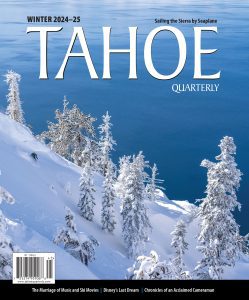
Bradly Scot Ross
Posted at 19:34h, 07 MayThanx, lov your history of the area!
Mostly ski-raced all over Tahoe & Cal.-Nevada from base @ (then) Squaw, from 1968-75. Was #7 of top 10 FWSA to Jr. Olympics in 1970.
Some summer recreation;.Loved it all!
Bradly Scot Ross
Posted at 19:39h, 07 MayNow a retired Carpenter, still active musician in Washington state..